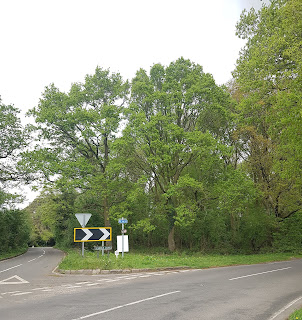Cookham Wildlife Supporters Half Term Nature Walk
You
know that expression “take time to stop and smell the roses”? I was reminded of that today when I joined
some of Cookham’s youngest residents on a nature walk led by Brian Clews of the
Cookham Wildlife Supporters. I met Bo aged about 6 (at a guess) and I
watched her as she looked at an acorn.
It wasn’t even a particularly nice acorn – it was a bit squashed. But she was completely absorbed in finding
out what was inside and telling me how it had been nibbled by a Squirrel
(something that Brian had just shown her on a pine cone). Little people don’t have much interrupting their
thoughts I guess. She was not looking at
the acorn at the same time wondering if the lasagne would de-frost in time for
supper. She and her friends with their
enthusiastic little hands up and their stomping through the puddles and their
waving sticks about, reminded me that we all need to take time to stop and have
a really good look.
I’ll
leave you to read Brian’s review of the event today. Partly because there are some long words in
there that I don’t understand, but mainly because I can’t do it better.
“We started off in the
Strande Park car park, with permission from the manager, John Sergeant, and
spent some time looking at overnight moths and insects caught in my garden. Cookham
Wildlife Supporter, Barry Weare had taken a pic of a ‘strange’ moth in his
garden which he could find no details of on-line. I’d already guessed what it
probably was before he showed his shot – a Box Tree Moth. And, as it happened,
I had caught yet another one in my garden moth trap last night so was able to
show everyone a live one I’d brought in a pot. They hail from Thailand as larva
on imported plant material, and are a serious pest for destroying Box forests
and hedges! I had caught about 70 so far this year, and picked off a similar
number of caterpillars off my own tiny Box Bushes in the garden!
We chatted about the
delightful Glow-Worms that could be seen around the car park in summer, and how
we may have to try and relocate them if the planned building work goes ahead on
the site.
We quickly got onto the
bridleway alongside the caravan park site with a 3km walk ahead of us as
planned. However, I did say that if there was a lot to see, we might only get a
200 metres – which is exactly what happened. We found a lot of plants in
various stages. Some in flower, and some in ‘winter plumage’. We learned which
stingers we should leave alone and which ones we could hold quite safely. We
found a pincushion that Mrs Robin uses! This is a gall on wild rose whereby a
miniscule wasp, Diplolepis rosae, laid an egg on its stem in spring, and
caused the chemicals in the plant to be modified and they create a different
type of material to the main plant. This ‘lump’ of material, in the case of the
Robin’s Pincushion, (or bedeguar gall, as it is technically known), creates a
nice protected little container for the larva of the wasp to grow in. It is
covered in tiny prickles (the ‘pins’) to protect it.
We found lichens, and
mosses of various sorts, and counted about 20 different plants in a small area
about 30cm square, and noted that only about 1cm down, the soil was mainly
sand, indicating why the plant types there were so different to the way-side
plants we had seen earlier. We studied some Ivy and saw how some was still in
flower, attracting lots of insects, whilst others had already started to form
berries which would feed birds over winter, and looked at the detailed design
of a Teasel to see why it is that only dainty-billed Goldfinches could
successfully extract its seeds. Some 16 species of bird were detected,
including some Bullfinches, which excited those who could find them in their
binoculars. We had a fly-past of a noisy, long-tailed green ‘parrot’ (the
notorious Ring-necked Parakeet,) 2,000 of which roost alongside the M4 opposite
Slough Sewage works! The ‘scratchy’ calls from a Magpie turned out to be an
angry Squirrel disputing its perch with its black-and-white neighbour.
Some of the children
collected some very pretty snail shells, including both white-lipped, and
brown-lipped forms of the common Cepaea nemoralis species, and a nice yellow
shell of Cepaea hortensis type (but in this one, Mrs snail was not at home!)
The last creature we saw,
as we said our farewells in the car park, was perhaps the most beautiful of all
we had seen: a gorgeous Red-Admiral butterfly."
Cookham
Wildlife Supporters is a voluntary group. Please consider supporting
by joining via the Meet Up page or the Facebook group. Events are run all year, for
every age group and the calendar can be found here.








Comments
Post a Comment